Banana Bread is one of the most popular recipes in the United States. It is more often searched for than bread, sourdough bread, and even chocolate chip cookies! It is also a recipe that I have made over a hundred times and perfected over many years.
I have put together a guide for baking banana bread using my years of banana bread baking experience, well over a dozen additional “test” banana breads, and a desire to learn even more.

In this guide, I cover topics such as ripeness of the bananas, how the sugar content of bananas changes, the shape and material of the baking dish, ingredient variations and plenty of tips and tricks.
Ultimately, the banana bread that is the best is the one that fits your specific tastes, especially in terms of how sweet, how much banana flavor, and how dense or fluffy it is. The guide below will help you to determine what is best for you!
Table of Contents
Jump to:
Control
I used my time honed recipe for banana bread as my control. It is simple and lower on butter and sugar than average which is made up for by the sweetness of the bananas. It uses 2 cups of mashed bananas which gives it a strong banana flavor. See the section on Ripe vs. Overripe Bananas below.
Below are the ingredients and quantities in my recipe. I do not use any special techniques to make this banana bread.
- ¼ cup butter, softened
- ½ cup granulated sugar
- 2 cups mashed bananas (4-5 medium bananas: in between ripe and overripe)
- 2 large eggs
- ½ teaspoon vanilla
- 1 teaspoon baking soda
- ½ teaspoon salt
- 1 ½ cups all-purpose flour
Ripe vs. Overripe Bananas
As bananas ripen their total sugar content and banana aroma increases. On average, when a banana goes from unripe (green) to slightly ripe (mostly yellow, some green), the sugar content increases by 275%. However, what might surprise you is that the sugar content only increases by 14% when a banana goes from slightly ripe (mostly yellow, some green) to ripe (solid yellow, a tiny bit brown, some green). And it decreases by 2% when the banana goes from ripe to overripe (lots of brown or black).
How Sugar Content Changes as Bananas Ripen:
- Unripe to Slightly Ripe: Increases 275%
- Slightly Ripe to Ripe: Increases 14%
- Ripe to Overripe: Decreases 2%
See the full study, Dietary fiber, starch, and sugars in bananas at different stages of ripeness in the retail market, published in the journal PLoS One in 2021 by Phillips et al.
What is perhaps less surprising is the aroma of a banana changes significantly as it ripens:
- underripe: "not significant"
- slightly ripe: "faint"
- ripe: "noticeably strong"
- overripe: "strong and pervasive"
Water content also increases as bananas ripen.

The photo above illustrates the difference between ripe and overripe bananas.
Based on the study and the changing sugar content of bananas, making banana bread with overripe brown bananas will not actually make your banana bread any sweeter. What it will do is give your banana bread a stronger “banana” flavor.
I wanted to verify and test this: that banana bread is not sweeter, but has a stronger flavor when using overripe bananas.
I made two loaves of banana bread side by side with the same recipe, ingredients, baking dish, timing and temperature. However one was made with overripe bananas and one with regular ripe bananas.
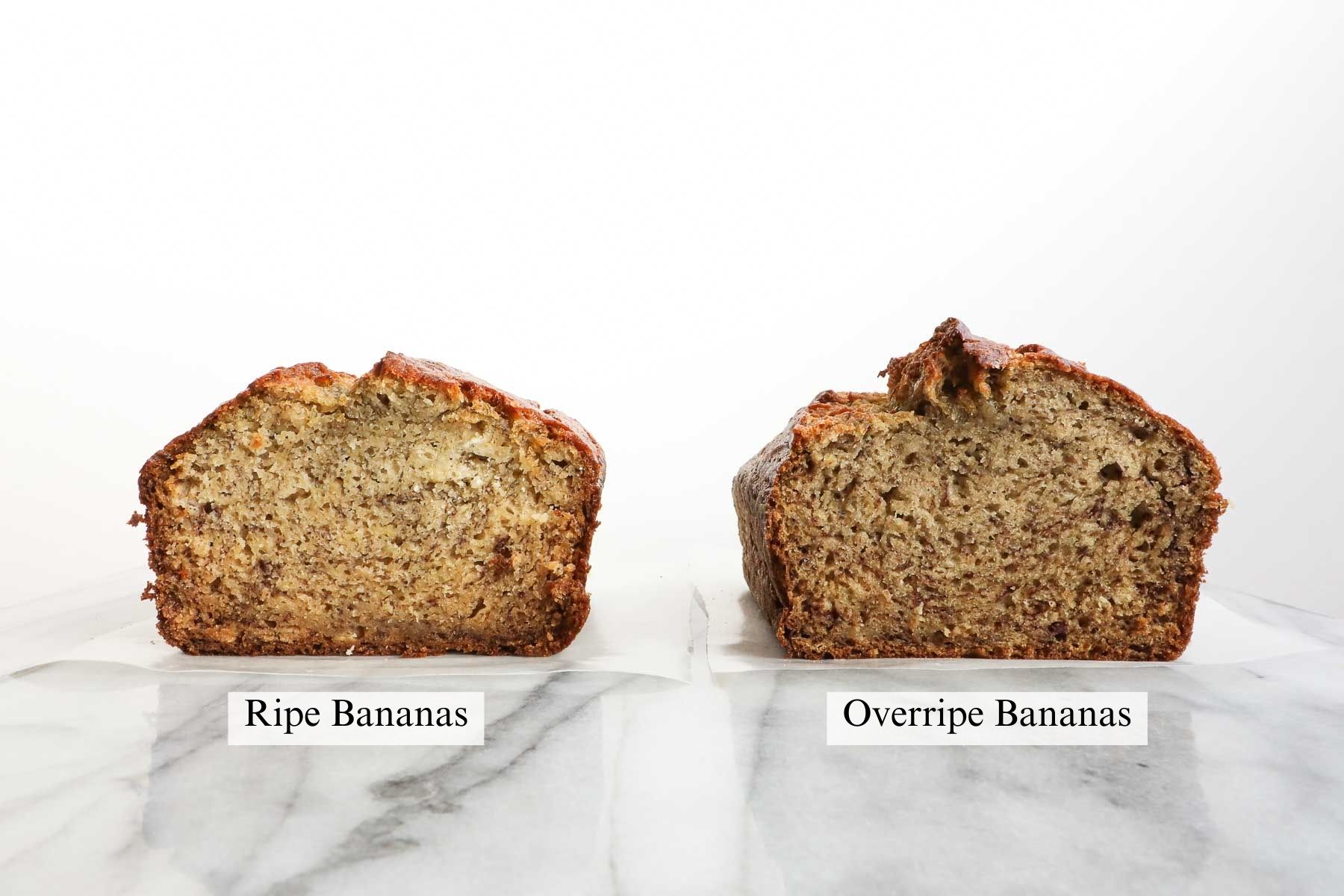
Here are the results:
Banana Bread with Ripe Bananas
- Bananas themselves had a mild-to-no banana smell
- Banana bread had a milder, but very pleasant banana flavor.
- The loaf rose less compared with the loaf made with overripe bananas
Banana Bread with Overripe Bananas
- Bananas themselves had a very strong banana smell.
- Banana bread had a VERY strong banana flavor. For me it’s a bit too intense.
- The loaf rose more than the loaf with regular ripe bananas
Both banana breads were equally sweet.
My Personal Preference: Banana bread with bananas in between ripe and overripe (middle bunch of bananas in the picture below). The bread with very overripe bananas tasted a little too strong of banana flavor, almost like imitation flavor put in candy.

The bananas that I classify as "Between ripe and overripe" are those that have some brown spots, but are more yellow than brown. They are also bananas that you may still consider eating on their own, or are getting towards the end of what you would consider edible.
If the peel starts to fall off when you pick up a banana, or it's more brown than yellow, or it's gotten to the point where you would not consider eating it on its own, that is overripe.
Dish Shape: Square vs. Loaf
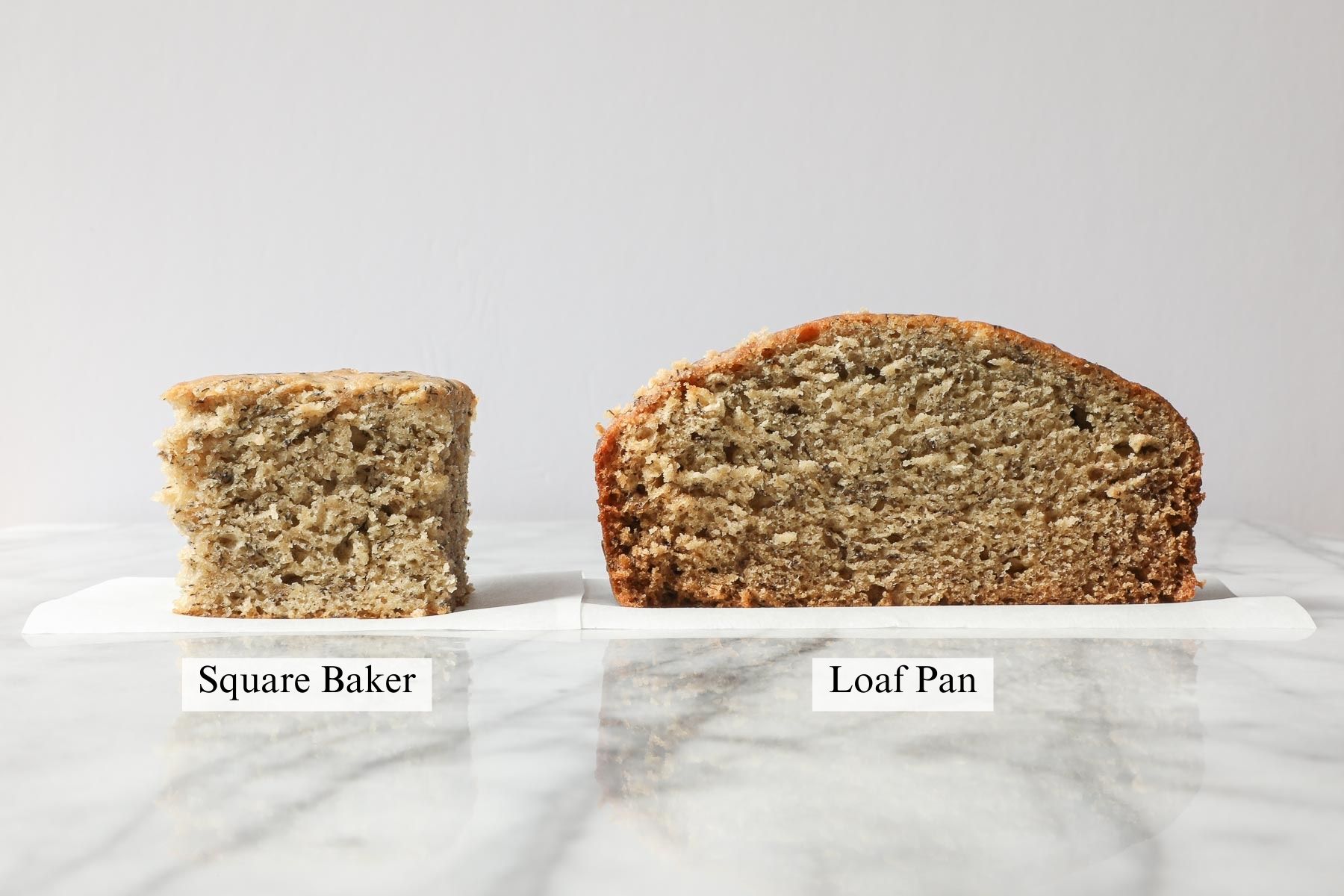
Banana bread is traditionally baked in a loaf pan, but I tend to prefer baking banana bread in a square baking dish.
I used my control recipe to bake both a loaf of banana bread and a square more cake-style banana bread and compared them side by side. The distance from the edge of the dish to the middle of the bread is more uniform in a square baking dish than a loaf pan.
I find that banana bread in a square dish bakes more evenly than in a loaf pan. The edges of the rectangular loaf of banana bread tend to be slightly overdone when the middle is perfectly done. In a square baking dish, the consistency and “doneness” of the bread is more even throughout.
I also found that the bread rose more in the square baking dish resulting in a lighter and fluffier banana bread, one that is more cake like in style.
In the photo above, you can see that the bottoms and edges of the loaf of banana bread on the right are darker, more cooked and denser. Whereas, the square baking dish, cake style is baked more evenly and is lighter and fluffier.
Keep in mind that banana bread in the square baker will have slightly denser edges at the edge of the baking dish, however the total volume of light and fluffy bread is higher for the square baker than with the loaf pan.
Dish Material: Metal vs. Ceramic
Does it matter if you use a metal or ceramic baking dish to bake banana bread?
Sweet breads are often baked in a metal (aluminum, steel, or aluminized steel) pans. Aluminum and aluminized steel pans conduct heat quickly and efficiently. They also do not retain heat for very long.
In this test, I baked four banana breads.
- Loaf Pan: Metal
- Loaf Pan: Ceramic
- Square Baker: Metal
- Square Baker: Ceramic
Loaf Pan: Ceramic vs. Metal

The performance of the ceramic loaf pan and the aluminum steel loaf pan were virtually identical. The consistency of both loaves was the same, fluffy in the middle and a little denser on the bottom and edges. The aluminum steel pan loaf was ever so slightly drier on the bottom, and slightly less crunchy on top. However, if I was blindfolded, I would not have been able to tell the difference.
The biggest difference was the baking time. The ceramic loaf pan took just over an hour, whereas the aluminum steel pan took 55 minutes. Though some of this is due to the difference in pan sizes.
The Williams Sonoma aluminized steel loaf pan that I used is 10x5, whereas the Emile Henry ceramic loaf pan that I used is 9x5. These are interior measurements, rather than the size of the dish itself. A longer loaf pan, all else equal, will result in a shallower bread, and require less baking time.
Square Baker: Metal vs. Ceramic
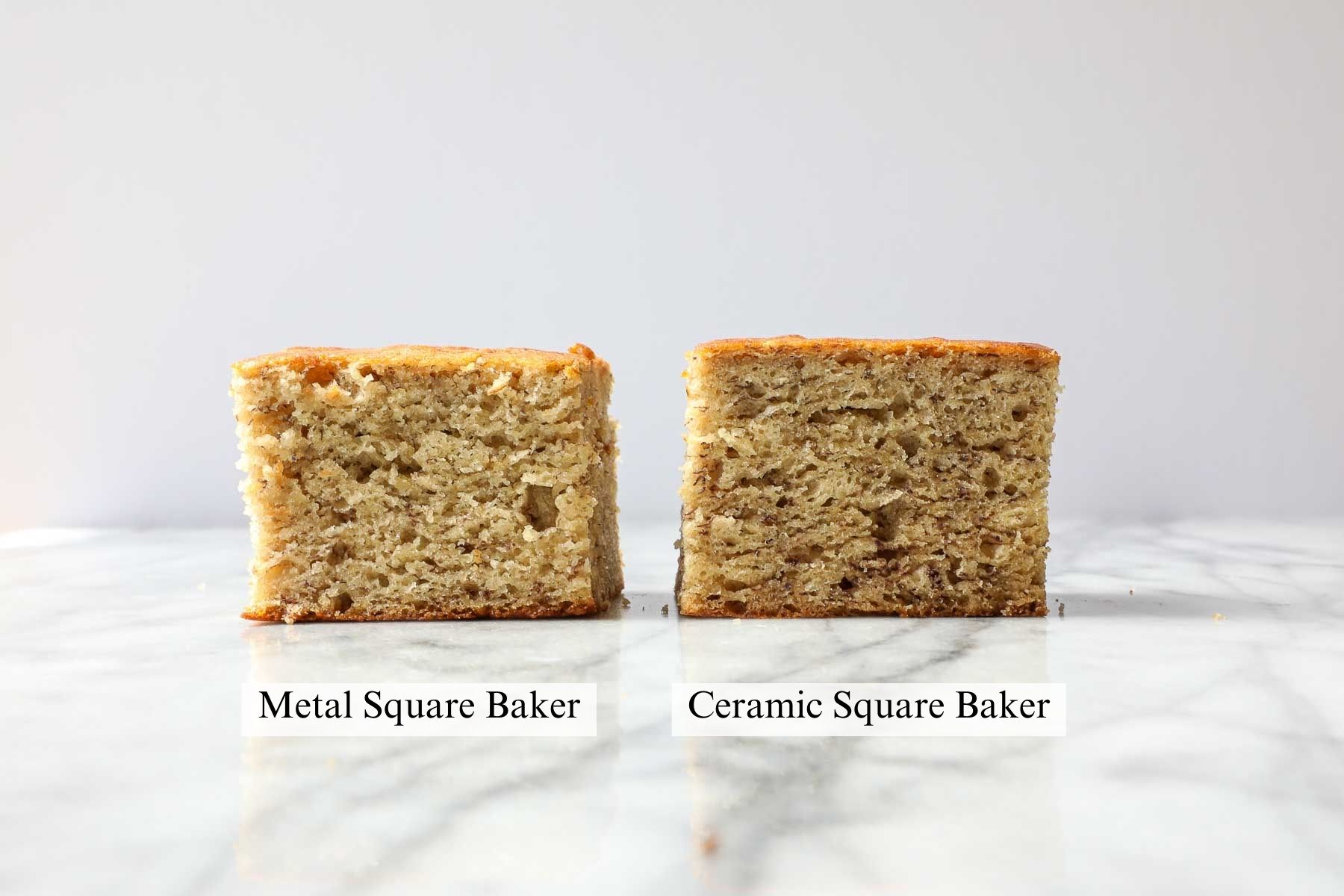
The performance of the metal and ceramic square baking dishes were also essentially the same. The banana bread in the ceramic dish was cooked more evenly throughout, however the difference was negligible.
Conclusion: Using a ceramic or metal baking dish did not impact the overall result of the banana bread. Just be aware of what size baking dish you are using and note that that may impact the baking time.
Use the toothpick test to determine when the bread is done and keep in mind that if you end up checking the bread multiple times, opening the oven door will decrease the temperature in the oven and extend the total baking time.
Store-bought vs. Homemade

To cover all the bases, I compared a loaf made with store-bought banana bread box mix vs. homemade banana bread. The banana bread made from the box mix was much lighter in color, fluffier, but lacking any real banana flavor. The homemade version was a million times better and not even really comparable to the store-bought box mix kind.
With Brown Sugar
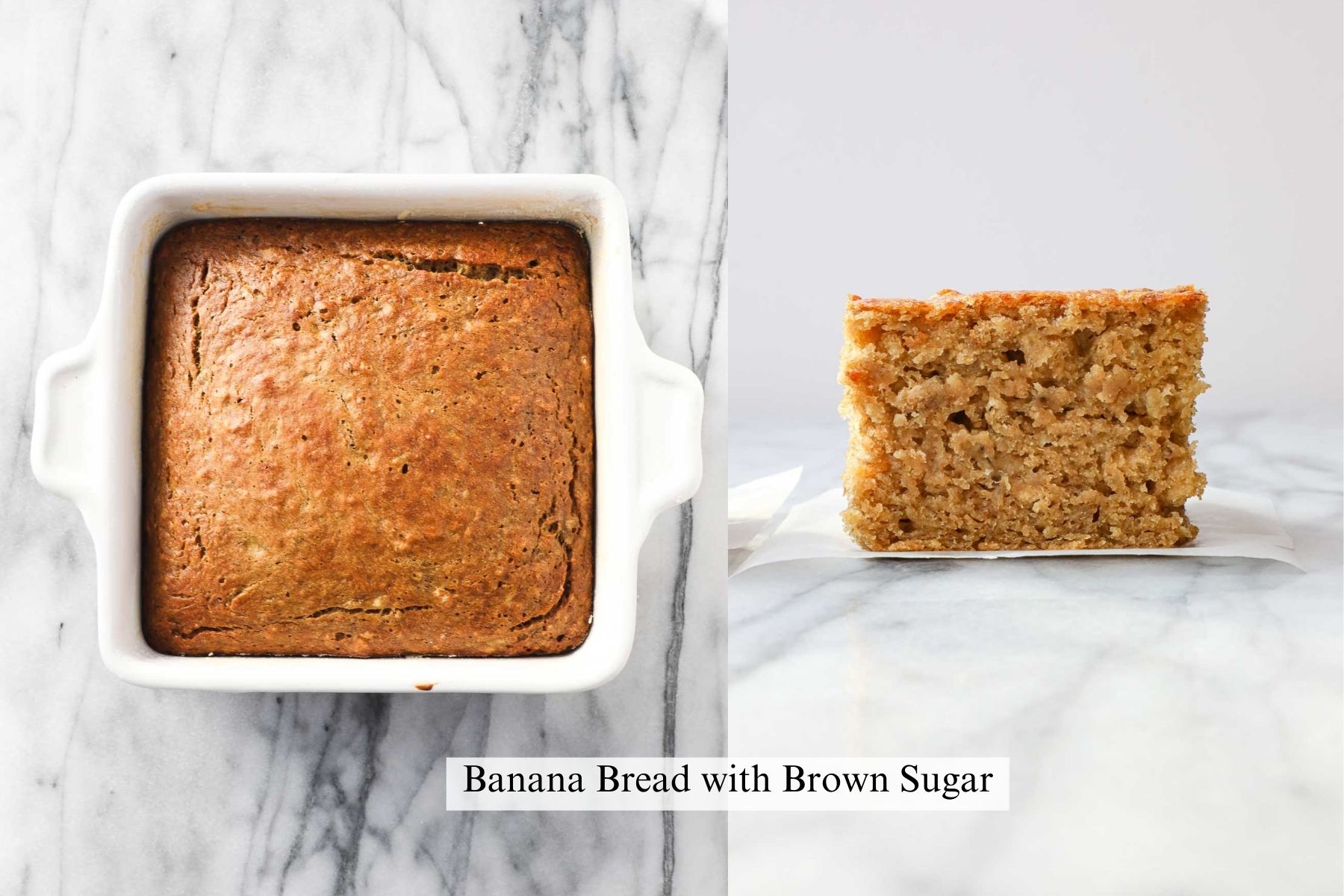
Substituting brown sugar for granulated sugar resulted in a banana bread that was slightly darker in color. However, a lot of the overall impact of color in any banana bread comes from the bananas. The biggest difference between using brown sugar vs. granulated sugar was that banana bread baked with brown sugar smelled a little more like “caramel”, like that wintry baked good smell associated with the holidays.
Yet, using brown sugar instead of granulated sugar did not have that big an impact on taste or consistency of the banana bread. It tasted sweet, just like when using granulated sugar, but the “caramel” aroma did not pull through into a “caramel” taste. The biggest impact to taste is how much sugar is added (either brown or granulated).
Cake Flour vs. All-purpose Flour

I made two loaves of banana bread, one with King Arthur unbleached all-purpose flour and one with King Arthur unbleached cake-flour. Cake flour is a finely milled flour and has lower protein and gluten content than all-purpose flour. It is used for certain light cakes, like angel food cake.
In my experiment, however, using cake flour did not result in a lighter or fluffier banana bread. The batter is very wet and dense due to the amount of mashed bananas. In the side-by-side comparison of banana bread with cake flour vs. all-purpose flour, I did not notice any difference in taste or texture.
With Sour Cream

Adding sour cream to banana bread creates an extra moist bread. The loaf that I tested used my control banana bread recipe with the addition of ½ cup of full-fat sour cream and an additional 2 tablespoon of flour to compensate for the extra water content. It also required a longer baking time.
The loaf with sour cream was very moist, but the banana flavor/intensity was more mellow. The sour cream (and extra flour needed) diluted the banana taste in the loaf. All in all, it was very good.
If you’re looking to make sure your banana bread is extra moist, add sour cream and a little extra flour. If you don’t mind or even prefer a milder banana flavor, adding sour cream will do the trick.
You can see in the photo that the bottom of the loaf is very dense and a little extra moist. This loaf likely would have benefited from an additional 2 or more tablespoon flour (for 1 ¾ cups total).
Too Many Bananas

Increasing the water content by incorporating too many bananas results in a banana bread that is denser and gummier. It has an unpleasant consistency and does not create that nice domed shape that you come to expect with a baked sweet bread like banana bread.
Too high a water content also prevents that nice slight crisp on the top crust that you get when using the correct proportion of wet ingredients to dry ingredients.
The picture above demonstrates what happens if you bake a banana bread with too many bananas and therefore too high a water content.
Freezing Banana Bread
Banana Bread is great to freeze. I have frozen many loaves of banana bread, both for testing purposes, and because after baking well over a dozen loaves for this experiment, I have had plenty of extras. Freezing and then thawing and reheating has little to no impact on the flavor or texture of the bread. This makes it a great candidate for making ahead and freezing, or freezing any leftovers.
To reheat, either leave in the fridge or on the counter overnight to thaw or cut into slices and place in the microwave. Heat for 1 minute at a time at 50% power until defrosted. Or if you’re impatient, microwave for 30 seconds at a time until defrosted.
Tips and Tricks
Below are a list of tips and tricks that I learned over many years of baking banana bread, and a few that I learned in the process of doing this experiment.
Mashing the Bananas: To make life easier, peel the bananas and add 1-2 inch chunks to a large 4-cup measuring pitcher. Then using a hand held beater, beat the bananas in the measuring pitcher. This way you do not have to mash the bananas by hand, and you know the exact amount of mashed bananas that you are adding to the batter.
Measuring Mashed Bananas: The amount of mashed bananas can dramatically change the result of your banana bread because the water content will change. For a precise result, mash and measure the amount of mashed bananas in a large measuring pitcher.
Amount of Sugar: I have found that for a standard loaf of banana bread you can use anywhere between ½ cup of sugar and 1 cup of sugar. Because bananas are already sweet, using ½ cup sugar is plenty for me, and makes the banana bread a little more suitable for most times of day. However, if you like really sweet things, or want to make your banana bread more of a sweet dessert add anywhere up to 1 cup of sugar. This will be very, very sweet. If you don’t know your preference, start with ¾ cup and you’ll determine whether this is just right or if you need more or less next time.
Do Not Overmix: One trick I use to prevent overmixing is to add all of the ingredients except the flour with a hand held beater. Then I add the flour and mix the flour in by hand with a large spoon until just combined. This helps to prevent overmixing. This in turn helps to prevent the development of gluten which will give you a lighter and softer banana bread.
Scoring the Loaf: If you want to create a nice design in the top of your loaf of banana bread, you can score the bread just like you would a loaf of sourdough bread before baking. Even though the batter is wet, use a sharp knife to create a curved line (or other design) down the middle of the loaf. It is okay if the score doesn’t “stay” because the batter is wet, it will still bake and gently split along that line (not perfectly, but still nicely).
Checking for Doneness: Insert a toothpick into the middle of the banana bread to check whether or not it is done. It should come out clean or with a few “dry” crumbs. It should not be coated in wet or moist batter. Keep in mind that if you end up checking if the bread is done multiple times, opening and closing the oven will reduce the oven temperature and prolong the overall time needed to bake the banana bread.
Oven and Temperature: Different ovens types and brands, and whether or not your oven is new will impact the amount of time needed to fully cook your banana bread. Check a few minutes before the recipe time to ensure that your banana bread is not over cooked. However, be wary of opening the oven too many times as it will drop the temperature inside the oven and impact the timing and consistency of the banana bread.
From 2022-2023 I traveled for a year and cooked in 10 different kitchens with different types of ovens (gas, electric, a variety of brands, some old, some brand new). From first-hand experience, the type of oven you use can have an impact on how long your baked goods need to be baked. If you want to be super precise, you can use an oven thermometer to check the temperature. Otherwise, get a feel for how your oven operates through trial and error.
Conclusion
Here are a few ways you can tailor your banana bread to your taste preferences:
- Square baking dish: lighter and fluffier, more cake like
- Loaf Pan: denser, but more classic
- Metal vs. ceramic baking dish: no impact
- Ripe bananas: milder flavor banana bread
- Overripe bananas: more intense banana flavor
- Brown sugar: no impact to taste
- Adding sugar: less sweet use ½ cup, very sweet use 1 cup in a standard loaf pan
- Sour cream: a very moist banana bread, but dilutes the banana flavor
- Cake flour: no impact to taste or texture
- Wet to Dry ingredients: be mindful of the ratio of wet to dry ingredients
Additional Resources
I’ve compiled a short list of resources below if you’d like to learn more about the history of banana bread, its popularity in the US, and King Arthur’s guide to baking pans.
One interesting point to note is that banana bread rose in popularity during the Great Depression as a way to avoid throwing out old bananas and making the most of scarce resources. This may be why many of us are inclined to use brown bananas for baking banana bread.
History of Banana Bread: King Arthur
CNBC #1 searched recipe in 2020 was banana bread
A Guide to Baking Pans: King Arthur
If you're interested in more sweet bread recipes you may love these:
Do you have any other questions or comments about baking banana bread? Any issues you tend to come across or helpful baking experiences? Leave a comment down below. I'd love to hear from you.







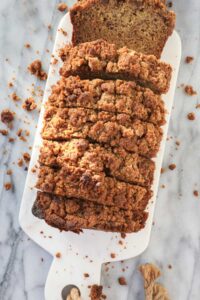
Leave a Reply
You must be logged in to post a comment.